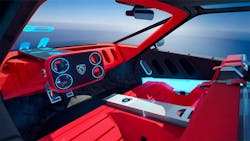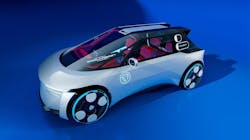Peugeot Debuts Hypersquare Controls and Steer-by-Wire Tech
What you'll learn:
- Peugeot revealed its next-generation concept car, dubbed the Peugeot Polygon. which boasts a Hypersquare steering wheel with steer-by-wire technology.
- Control in steer-by-wire is entirely electronic; there’s no physical connection between steering and wheels, so there’s no steering column.
- Peugeot says the Polygon is a drivable prototype built to preview innovations you’ll see in production models from 2027 onward.
We have been driving for over a century, and in all this time, the shape of the steering wheel has hardly changed: We grip a mostly round steering wheel. However, a new approach is on the way.
Peugeot’s Polygon, a fully electric city vehicle prototype built to preview innovations you’ll see in production models from 2027 onward, includes what it calls a Hypersquare electronic steer-by-wire system. It replaces the traditional steering wheel with fingertip controls at four pods located at each corner.
With steer-by-wire technology, it’s possible to steer a vehicle's wheels without a steering column that turns the direction of those wheels. This setup eliminates mechanical connections between the wheel and tires, which Peugeot says improves agility at both low and high speeds, delivering “exceptional responsiveness” by filtering out unwanted vibrations while maintaining road feel.
The Hypersquare control opens the door to numerous possibilities. Removing the mechanical connection between the steering and the front wheels, the system can adjust its ratio depending on speed. The car is controlled via small, easy movements. There’s a maximum rotation of just 170° in each direction — and minimal input is required at higher speeds to make the car feel more secure.
Personalizing Your Car
Peugeot also says customization is a key element of Polygon. Drivers can swap interior materials, front and rear lighting signatures, dashboard elements, and even steering wheel finishes within minutes.
You can even customize the Goodyear tires. Goodyear has developed laser-engraved tires with colored sidewalls to complement the concept’s configurable aesthetic. The tires are supported by the brand’s SightLine suite of tire intelligence software offerings for real-time road and tire condition information. Goodyear’s suite of intelligent mobility solutions features real-time tire health diagnostics, road surface sensing, and predictive maintenance insights.
If Polygon looks like it was pulled from a video game, in a sense, that’s true. In partnership with Gameloft, a developer and publisher of multiplatform games, the Peugeot concept vehicle shows up as game island Peugeot Polygon City inside the Fortnite game universe.
In this way, Peugeot provides fans and gamers an opportunity to discover the key features of Polygon Concept. The player is dropped onto the island, where they will immediately recognize the Hypersquare shape from an aerial view as they dive in.
MicroLED Displays
Peugeot’s i-Cockpit has been pushed into new territory. Inside, the Polygon exchanges a traditional instrument panel for a large microLED display placed behind the Hypersquare controller, projecting a full infotainment display directly onto the windshield.
Removing conventional dashboard screens frees up cabin space and gives the driver a projected image that’s equivalent to a 31-in. display, directly in their line of sight. All essential information, such as speed, data, and more, are instantly accessible — all at eye level and in real-time.
This system supports different visual environments depending on whether the car is stationary or in motion. Peugeot has designed lighting and animations that synchronize both inside and outside the vehicle (live in-vehicle information can be seen from outside). The Polygon concept enhances the vehicle charging experience with a dedicated microLED display located on the side of the vehicle. The screen allows users to check the vehicle’s charge level wihtout entering the car.
Sustainability plays a major role in the Polygon concept’s construction. There’s a focus on recycled materials and reduced component counts, with textiles made from dismantled Peugeot seats used across the cabin, and 3D-printed shells forming the base of the new seats. Even the interior lacquer contains recycled materials sourced from end-of-life tires. The automaker says fewer parts mean not only lighter weight, but also easier end-of-life disassembly and maintenance.
Polygon is breaking boundaries in its production methods, too. The concept car employs 3D-printing technology from Nagami, a company that transforms designs through large-format 3D printing and recyclable materials. For example, Polygon’s seats are made from recycled PET plastic. Each seat is comprised of just three parts: the shell, frame, and foam.
Fewer parts means use of fewer raw materials, less energy used in manufacturing, and less production time. If Polygon owners wish to match the seat to their mood, they can swap the foam in minutes for new colors and new shapes.



